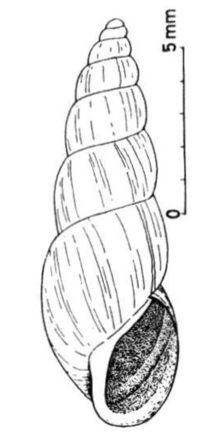Omphiscola glabra
Omphiscola glabra (Synonym: Stagnicola glaber (O. F. Müller, 1774) [2]) is a species of small to medium-size, air-breathing, freshwater snail, an aquatic pulmonate gastropod mollusk in the family Lymnaeidae.[3]
| Omphiscola glabra | |
|---|---|
| A live individual of Omphiscola glabra on a paper grid, scale bar 1 cm | |
| Scientific classification | |
| Kingdom: | |
| Phylum: | |
| Class: | |
| (unranked): | |
| Superfamily: | |
| Family: | |
| Subfamily: | Lymnaeinae |
| Genus: | |
| Species: | O. glabra |
| Binomial name | |
| Omphiscola glabra | |
| Synonyms | |
| |
Omphiscola glabra is the type species of the genus Omphiscola.[4]
Distribution
This European snail can be found from southern Scandinavia (61° N) to southern Spain.[5]
- endangered in Germany. Critically endangered in Western Germany (Rheinland-Pfalz, Saarland, Nordrhein-Westfalen, Hessen). Extinct in Bavaria.[5]
- Netherlands
- one site in the south east of Ireland was found in 2009, but it is listed as extinct on the local Red List (2009).[6]
- vulnerable in Great Britain[5]
The distribution of Omphiscola glabra is very scattered and rare.[5] It is seriously threatened, and has become locally extinct in many places.[5] It is threatened by continuing habitat destruction because of drainage and intensive farming.[5] Acriculturally induced eutrophication is also a threat. Omphiscola glabra has disappeared widely from urbanized areas such as London.[5]

Shell description
The shell is strongly cylindrical, horny, often with a brownish or blackish surface, the apex is blunt, 7-8 moderately convex whorls, with last whorl being twice as high as the narrow aperture, and with aperture often with white lip.[5]
The height of the shell is 9–12 mm,[5] up to 15 mm[7] or up to 20 mm.[5] The width of the shell is 3–4 mm,[5] up to 5.5 mm.[7]

Habitat
This snail lives in places such as swampy meadows and ditches.[8]
Omphiscola glabra is said to occur in small areas of standing water that have a lot of vegetation such as swamps, and also in standing forest waters with leaf litter, often in water with organic iron contents and low calcium contents.[5]
In Central France, the populations of Omphiscola glabra are currently declining because its habitat is threatened by modern agricultural practices.[9]
In Britain however, this species occurs in small standing waters that are low in nutrients, with poor aquatic flora, often in waters drying out periodically.[5] They usually do not occur in habitats with high molluscan diversity, and usually in habitats on uncultivated land.[5] They are calciphile and have a pH tolerance of 5.4-8.8.[5]
Reproduction begins in May.[5] Juveniles hatch after 15–25 days.[5] Omphiscola glabra has two generations per year.[5]
Parasites
Omphiscola glabra can serve as an intermediate host for several digenean trematodes. In France, Omphiscola glabra is naturally infected with Fasciola hepatica,[10] Calicophoron daubneyi,[11] and Haplometra cylindracea.;[12] in all, seven digenean species parasitize O. glabra in the Brenne Regional Natural Park, central France.[13] Moreover, a report suggests that the species is also susceptible to Fascioloides magna infection.[14]
References
This article incorporates public domain text from the reference.[5]
- Müller O. F. (1774). Vermivm terrestrium et fluviatilium, seu animalium infusoriorum, helminthicorum, et testaceorum, non marinorum, succincta historia. Volumen alterum. pp. I-XXXVI [= 1-36], 1-214, [1-10]. Havniae & Lipsiae. (Heineck & Faber).
- https://www.biolib.cz/en/taxon/id16606/
- Glöer P. (2002). Überfamilie Lymnaeoidea Rafinesque 1815. Familie Lymnaeidae Lamarck 1812. In: Glöer P. (ed.) Die Süßwassergastropoden Nord-und Mitteleuropas. Bestimmungschlüssel, Lebensweise, Verbreitung. Die Tierwelt Deutschlands 73. Conchbooks, Hackenheim, pp. 200–232.
- "Species in genus Omphiscola". AnimalBase, accessed 31 July 2010.
- "Species summary for Omphiscola glabra". AnimalBase. Last modified 24-02-2009, accessed 31 July 2010.
- Anderson R. (2009). "Value of species datasets as baselines (non-marine Mollusca)" Archived 24 July 2011 at the Wayback Machine. accessed 31 July 2010.
- (in Polish) Jackiewicz M. (2000). Blotniarky Europy (Gastropoda: Pulmonata: Lymnaeidae). Wydawnictwo Kontekst, Poznań. 115 pp.
- Rondelaud, D.; Vignoles, P.; Dreyfuss, G. (2009). "First field observations on the aestivation of Omphiscola glabra (Gastropoda, Lymnaeida) uninfected or infected with Fasciola hepatica in central France". Annales de Limnologie - International Journal of Limnology. 39 (2): 129–133. doi:10.1051/limn/2003010. ISSN 0003-4088.
- Dreyfuss, Gilles; Vignoles, Philippe; Rondelaud, Daniel (2016). "Current decline in the number and size of Galba truncatula and Omphiscola glabra populations, intermediate hosts of Fasciola hepatica, on the acidic soils of Central France". Parasite. 23: 46. doi:10.1051/parasite/2016055. PMC 5086825. PMID 27774956.

- Dreyfuss, G.; Vignoles, P.; Rondelaud, D. (2003). "Natural infections of Omphiscola glabra (Lymnaeidae) with Fasciola hepatica in central France". Parasitology Research. 91 (6): 458–461. doi:10.1007/s00436-003-0892-8. ISSN 0932-0113.
- Abrous, M.; Rondelaud, D.; Dreyfuss, G.; Kabaret, J. (1999). "Infection of Lymnaea truncatula and Lymnaea glabra by Fasciola hepatica and Paramphistomum daubneyi in farms of central France". Vet. Res. 30 (1): 113–118. PMID 10081118.
- Goumghar, M. D.; Abrous, M.; Ferdonnet, D.; Dreyfuss, G.; Rondelaud, D. (2000). "Prevalence of Haplometra cylindracea infection in three species of Lymnaea snails in central France". Parasitol. Res. 86 (4): 337–339. doi:10.1007/s004360050054. PMID 10780746.
- Rondelaud, Daniel; Vignoles, Philippe; Dreyfuss, Gilles (2015). "Larval trematode infections in Lymnaea glabra populations living in the Brenne Regional Natural Park, central France". Parasite. 22: 38. doi:10.1051/parasite/2015038. ISSN 1776-1042. PMC 4686325. PMID 26692260.

- Rondelaud, D.; Novobilský, A.; Vignoles, P.; Treuil, P.; Koudela, B.; Dreyfuss, G. (2006). "First studies on the susceptibility of Omphiscola glabra (Gastropoda: Lymnaeidae) from central France to Fascioloides magna". Parasitol. Res. 98 (4): 299–303. doi:10.1007/s00436-005-0067-x. PMID 16362339.
External links
- Omphiscola glabra at Animalbase taxonomy,short description, distribution, biology,status (threats), images
| Wikimedia Commons has media related to Omphiscola glabra. |
| Wikispecies has information related to Omphiscola glabra |